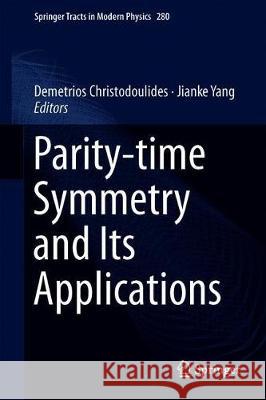Parity-Time Symmetry and Its Applications » książka



Parity-Time Symmetry and Its Applications
ISBN-13: 9789811312465 / Angielski / Twarda / 2018 / 579 str.
Parity-Time Symmetry and Its Applications
ISBN-13: 9789811312465 / Angielski / Twarda / 2018 / 579 str.
(netto: 843,44 VAT: 5%)
Najniższa cena z 30 dni: 848,19
ok. 22 dni roboczych
Dostawa w 2026 r.
Darmowa dostawa!
This book offers a comprehensive review of the state-of-the-art theoretical and experimental advances in linear and nonlinear parity-time-symmetric systems in various physical disciplines, and surveys the emerging applications of parity-time (PT) symmetry.
Mathematical and physical PT theory:
1. Demetrios Christodoulides and Jianke Yang
“Introduction”
2. Carl Bender (Washington University in St. Louis, USA):
“Overview of PT symmetry in quantum mechanics”
3. Hugh Jones (Imperial College London, UK):
“Analysis of PT-symmetric gratings beyond the paraxial approximation”
4. Ali Mostafazadeh (Koc University, Turkey) “PT symmetry and Pseudo-Hermiticity in Quantum Mechanics”5. Nimrod Moiseyev (Technion, Israel),
“Non-Hermitian Quantum Mechanics”
6. Panos Kevrekidis (University of Massachusetts Amherst, USA) “Discrete PT systems”7. Vladimir Konotop (University of Lisbon, Portugal)
“Nonlinear dynamics in PT-symmetric systems”
8. Igor Barashenkov (University of Cape Town, South Africa) “Hamiltonian structures of some nonlinear PT systems”9. Dmitry Pelinovsky (McMaster University, Canada)
“Mathematical theory of nonlinear discrete PT-symmetric lattices”
10. Jianke Yang (University of Vermont, USA) “Generalization of PT symmetry to non-PT systems”11. Demetrios Christodoulides (University of Central Florida, USA)
“Overview of PT symmetry in Optics”
12. Stefano Longhi (Politecnico di Milano, Italy) “PT symmetric optical structures”13. Stefan Rotter (Vienna University of Technology, Austria)
“Mode conversion via encircling exceptional points”
14. Konstantinos Makris (University of Crete, Greece)“PT-synthetic optical lattices”
15. Ramy El-Ganainy (Michigan Technological University, USA)
“Non-Hermitian non-linear optics”
16. Tsampikos Kottos (Wesleyan University, USA)
“PT symmetry in electronics”
17. Douglas Stone (Yale University, USA)
“CPA lasers”
18. Jan Wiersig (Otto-von-Guericke-Universitat Magdeburg, Germany) “Sensing using exceptional points”19. Yuri Kivshar (Australian National University)
“PT symmetry in nonlinear optical structures”
20. Elena Ostrovskaya (Australian National University)
“Exceptional points in atomic condensates”
21. Jennifer Dionne (Stanford University, USA)
“Parity-time-symmetric plasmonic metamaterials”
PT Experiments:
22. Mercedeh Khajavikhan (University of Central Florida, USA)
“Physics and applications of PT-symmetric microcavities and exceptional points”
23. Lan Yang (University of Washington, USA)
“PT-symmetric optical dynamics in high-Q optical microcavities”
24. Ulf Peschel (University of Erlangen-Nürnberg, Germany) “Observation of PT-symmetric effects in mesh lattices”25. Min Xiao (Nanjing University, China)
“PT-symmetry in atomic systems and microcavities”
26. Liang Feng (State University of New York at Buffalo, USA)
“PT-symmetric single-mode lasers”
27. Xiang Zhang (University of California Berkeley, USA)“Acoustic PT symmetry”
28. Andrea Alu (University of Texas at Austin, USA)
“PT-symmetric metamaterials”
29. Marin Soljacic (MIT, USA)
“Exceptional lines in photonic crystals”30. Alex Szameit (Universitat Jena, Germany)
“Non-Hermitian photonic lattices”
Demetrios Christodoulides is the Cobb Family Endowed Chair and Pegasus Professor of Optics at CREOL-the College of Optics and Photonics of the University of Central Florida. He received his Ph.D. degree from Johns Hopkins University in 1986 and subsequently joined Bellcore as a post-doctoral fellow. Between 1988 and 2002 he was with the faculty of the Department of Electrical Engineering at Lehigh University. His research interests include linear and nonlinear optical beam interactions, synthetic optical materials, optical solitons, and quantum electronics. He has authored and co-authored more than 350 papers. He is a Fellow of the Optical Society of America and the American Physical Society. He is the recipient of the 2011 Wood Prize and 2018 Max Born Award of OSA.
Jianke Yang is a professor of applied mathematics and University Scholar at the University of Vermont. He received his Ph.D. degree from MIT in 1994. His research focuses on nonlinear waves and nonlinear optics. He is the managing editor of the journal Studies in Applied Mathematics, and a member of the editorial board of Physical Review E. He is also the founding and general co-chair for the international conference series: Nonlinear Waves: Theory and Applications. He has published over 130 journal articles and two research monographs.
This book offers a comprehensive review of the state-of-the-art theoretical and experimental advances in linear and nonlinear parity-time-symmetric systems in various physical disciplines, and surveys the emerging applications of parity-time (PT) symmetry. PT symmetry originates from quantum mechanics, where if the Schrodinger operator satisfies the PT symmetry, then its spectrum can be all real. This concept was later introduced into optics, Bose-Einstein condensates, metamaterials, electric circuits, acoustics, mechanical systems and many other fields, where a judicious balancing of gain and loss constitutes a PT-symmetric system. Even though these systems are dissipative, they exhibit many signature properties of conservative systems, which make them mathematically and physically intriguing. Important PT-symmetry applications have also emerged. This book describes the latest advances of PT symmetry in a wide range of physical areas, with contributions from the leading experts. It is intended for researchers and graduate students to enter this research frontier, or use it as a reference book.
1997-2025 DolnySlask.com Agencja Internetowa
KrainaKsiazek.PL - Księgarnia Internetowa









